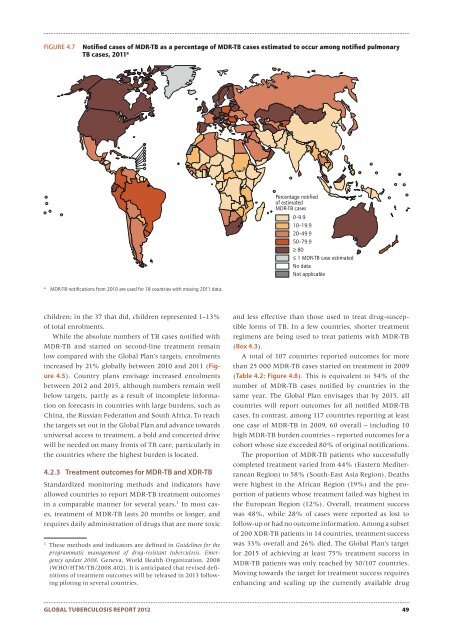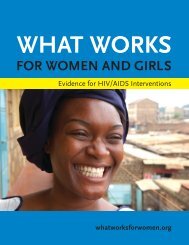Global Tuberculosis Report -- 2012.pdf
Global Tuberculosis Report -- 2012.pdf
Global Tuberculosis Report -- 2012.pdf
Create successful ePaper yourself
Turn your PDF publications into a flip-book with our unique Google optimized e-Paper software.
FIGURE 4.7Notified cases of MDR-TB as a percentage of MDR-TB cases estimated to occur among notified pulmonaryTB cases, 2011 aPercentage notifiedof estimatedMDR-TB cases0–9.910–19.920–49.950–79.9≥ 80≤ 1 MDR-TB case estimatedNo dataNot applicableaMDR-TB notifi cations from 2010 are used for 18 countries with missing 2011 data.children; in the 37 that did, children represented 1–13%of total enrolments.While the absolute numbers of TB cases notified withMDR-TB and started on second-line treatment remainlow compared with the <strong>Global</strong> Plan’s targets, enrolmentsincreased by 21% globally between 2010 and 2011 (Figure4.5). Country plans envisage increased enrolmentsbetween 2012 and 2015, although numbers remain wellbelow targets, partly as a result of incomplete informationon forecasts in countries with large burdens, such asChina, the Russian Federation and South Africa. To reachthe targets set out in the <strong>Global</strong> Plan and advance towardsuniversal access to treatment, a bold and concerted drivewill be needed on many fronts of TB care, particularly inthe countries where the highest burden is located.4.2.3 Treatment outcomes for MDR-TB and XDR-TBStandardized monitoring methods and indicators haveallowed countries to report MDR-TB treatment outcomesin a comparable manner for several years. 1 In most cases,treatment of MDR-TB lasts 20 months or longer, andrequires daily administration of drugs that are more toxic1These methods and indicators are defined in Guidelines for theprogrammatic management of drug-resistant tuberculosis, Emergencyupdate 2008. Geneva, World Health Organization, 2008(WHO/HTM/TB/2008.402). It is anticipated that revised definitionsof treatment outcomes will be released in 2013 followingpiloting in several countries.and less effective than those used to treat drug-susceptibleforms of TB. In a few countries, shorter treatmentregimens are being used to treat patients with MDR-TB(Box 4.3).A total of 107 countries reported outcomes for morethan 25 000 MDR-TB cases started on treatment in 2009(Table 4.2; Figure 4.8). This is equivalent to 54% of thenumber of MDR-TB cases notified by countries in thesame year. The <strong>Global</strong> Plan envisages that by 2015, allcountries will report outcomes for all notified MDR-TBcases. In contrast, among 117 countries reporting at leastone case of MDR-TB in 2009, 60 overall – including 10high MDR-TB burden countries – reported outcomes for acohort whose size exceeded 80% of original notifications.The proportion of MDR-TB patients who successfullycompleted treatment varied from 44% (Eastern MediterraneanRegion) to 58% (South-East Asia Region). Deathswere highest in the African Region (19%) and the proportionof patients whose treatment failed was highest inthe European Region (12%). Overall, treatment successwas 48%, while 28% of cases were reported as lost tofollow-up or had no outcome information. Among a subsetof 200 XDR-TB patients in 14 countries, treatment successwas 33% overall and 26% died. The <strong>Global</strong> Plan’s targetfor 2015 of achieving at least 75% treatment success inMDR-TB patients was only reached by 30/107 countries.Moving towards the target for treatment success requiresenhancing and scaling up the currently available drugGLOBAL TUBERCULOSIS REPORT 2012 49
















